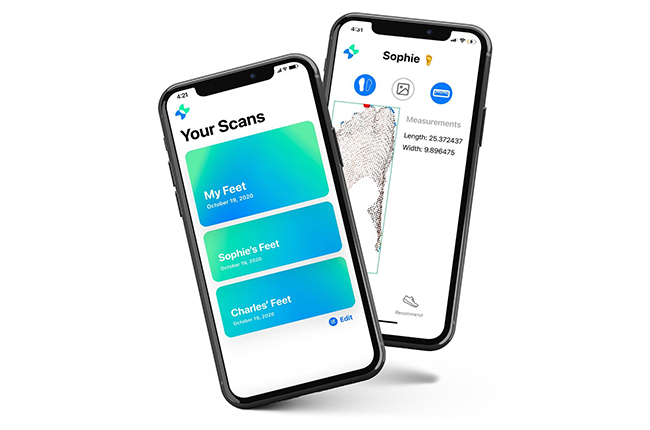
December 21, 2020
By Matthew Tierney
If the shoe fits, wear it — but what if you’re shopping online, as so many people are these days? Xesto, a startup with roots in the University of Toronto Early Stage Technologies (UTEST) program, has a solution through a collaboration with researchers in The Edward S. Rogers Sr. Department of Electrical & Computer Engineering (ECE).
The company, in collaboration with a team of graduate students from ECE, has developed software that uses iPhone’s FaceID camera to accurately size your feet. Xesto’s free iOS app made its debut in early December, in time for the gift-giving season.
The procedure for the consumer is very easy: take four different pictures of your foot, press a button and it’s done.
“That’s the magic behind it,” says Jeffrey Qiu. He, along with fellow ECE Master’s student Najah Hassan and MEng student Jungson Shao, is working behind the scenes on the 3D-scanning technology. “The user doesn’t need to know what mathematical transformations are reconstructing the foot from point cloud frames.”
Hassan explains. “Point clouds are similar to pixels. What pixels are to 2D, point clouds are to 3D. With different point clouds across time you can arrive at an image with depth.”
Both Qiu and Hassan, who are supervised by ECE Chair Professor Deepa Kundur, have been interested in this technology — which lies at intersection of computer vision, image processing and differential geometry — since their undergrad days.
Since any 3D printing, scanning or visualization technology can benefit from point cloud reconstruction, Qiu and Hassan’s early notions of possible applications gravitated toward the large and the expensive: health care, self-driving cars, even space exploration. Stepping out of the classroom and into the world of entrepreneurship has been enlightening.
“What really stood out for me at Xesto,” Hassan says, “was that they were using something so innovative and new at a level that could impact the everyday consumer. I didn’t think of using it for anything other than cars! That blew me away.”
Xesto — named after the Galician word for “gesture” — began in 2015 as a project in touchless human computer interaction, specifically in gesture recognition and hand tracking. This all changed with the 3D-depth camera added to iPhone X in 2017.
Already with one patent and another pending, Xesto’s algorithms have managed to come within 1.5 mm of accuracy. Xesto takes this measurement and cross-references with the sizing guidelines of over 150 different shoe brands to fine-tune its predicted fit.
Co-founder and CEO Sophie Howe (BCOM ‘18) says that Xesto’s acceptance into UTEST “was a pivotal moment in its evolution. It was our entry to the U of T startup community, which has provided us with an incredible amount of resources and a launchpad that enabled our growth.”
Howe has a background in finance and economics while co-founder Afiny Akdemir is working toward his PhD in applied mathematics at U of T. The core team was assembled through their U of T relationships, including former and current students from Professor Kundur’s lab.
The collaboration with ECE researchers was enabled by the Ontario Centres of Excellence (OCE) Voucher for Innovation and Productivity (VIP) program which supports R&D collaborations between companies and universities. “The startup ecosystem in Toronto is vibrant, thanks in large part to partnerships between industry and academia,” says Kundur. “Programs like OCE’s VIP program help to build bridges between the two and catalyze the economic benefit to companies while providing important experiential learning opportunities for the students.”
Qiu and Hassan both remark on how inspiring it’s been to see young entrepreneurs, not much older than themselves, turn technical and business expertise into a fully executed vision.
“The ECE research ecosystem is rich because of the tremendous opportunities available through our partnerships,” says Kundur. “Working closely with startups such as Xesto provides a unique catalyst for research innovations that lead to rapid tech transfer.”
More information:
Jessica MacInnis
External Relations Manager
The Edward S. Rogers Sr. Department of Electrical & Computer Engineering
416-978-7997; jessica.macinnis@utoronto.ca